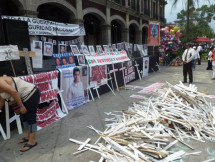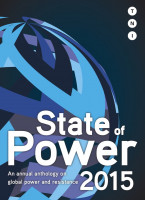The recent forced disappearance of 43 students in Iguala increased the international public recognition of uncertain, inscrutable and complex power relations in contemporary Mexico. On 26 September 2014, students of the Rural Teachers’ College of Ayotzinapa were stopped and attacked by local police forces. Six of them were killed during the confrontation and 43 more were arrested and handed over to a local organized crime cell by the police force under the instruction of the mayor. One of the missing has been proven dead and the remaining 42 are also feared dead but there is no scientific proof to confirm it.
This tragedy sparked ongoing mass mobilisations across the country supported by a variety of symbolic protest events in cities all over the world. The continuing social protests – one attracted an estimated 100,000 people – express protesters’ anger regarding the felt and experienced public insecurity in Mexico. Since the implementation of so-called “drug war” politics in 2006 that officially aimed to fight organ- ised crime cells, the number of forced disappearances and deaths of civilians has increased steadily. Those incidents go far beyond clashes between state forces and drug cartels that kill civilians caught in crossfire.
What the Ayotzinapa disappearances exemplify is a much deeper phenomenon in which civil society suffers from the unscrupulous enforcement and protection of particular interests in a highly profitable and diversified illegal economy – from drugs to weapons to human trafficking to product piracy. The complicity of organised crime cells and public authorities who protect their own operations of illegal enrichment through the exercise of violence has been well documented.4 These actors thrive in a na- tional context of institutional and democratic weakness caused by corruption and impunity. The resulting unrestricted power of those private interests feeds current and past social protests in the country.
For a deeper understanding of the role of civil society5 as a counter-power in this context, I will trace the particular trajectories of the Movement for Peace with Justice and Dignity (MPJD). At the national level, this social movement was the first publicly recognised actor to denounce rising insecurity in Mexico by centring on the victims of drug war politics. From the beginning in 2011 the MPJD challenged the damaging power relationships in Mexico and sought to end drug war politics due to its disastrous humanitarian consequences at home. But the movement progressively ‘scaled-up’ its protests from local and national scope to international mobilisation to raise awareness of the complex transnational relations and the implications of the UN-pursued drug prohibitionist framework that aims to globally control and reduce illicit drug use by the prohibition of specific substances.6
This essay is based on my own fieldwork research experiences with MPJD, conducted in 2012 and 2014 in Mexico and the US. The insights gained by participating in movement meetings and some protest activities shape my understanding of the strategies deployed and their impact. The essay aims to answer the central question of how movement members have been effective at shaping the relations between state politics and organised crime. Special attention is given to the spatial dimension of MPJD protest activities – the ‘where’ and ‘why’ – to shed light on the dynamics, tactics and effects of mobilisations as well as the movement’s empowering processes.
Pages: 12


